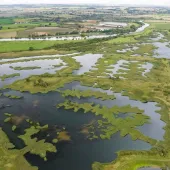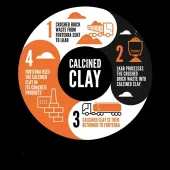Jurassic plesiosaur skeleton unveiled to the public

Rare fossil found at Must Farm Quarry goes on show at Oxford University Museum of Natural History
A RARE 165 million-year-old plesiosaur skeleton, discovered at Forterra’s Must Farm Quarry, near Peterborough, has been unveiled to the public after the company donated the find to Oxford University Museum of Natural History.
The long-necked marine reptile was found by a group of palaeontologists from the Oxford Clay Working Group in November 2014. The 5.5m long fossil is now on display for the first time, alongside a second, short-necked plesiosaur, at an exhibition called Out of the Deep.
Visitors to the Oxford University Museum of Natural History will be able to see the virtually complete skeletons of the sea creatures, which became extinct around 66 million years ago.
Brian Chapman, Forterra’s head of land and mineral resources, said: ‘We are thrilled that such a rare and important prehistoric specimen was unearthed at our Must Farm Quarry, and we were happy to be able to donate it to the museum where it has been studied by leading palaeontologists before going on display for everyone to see.’
The larger specimen was first spotted by Oxford Clay Working Group member Carl Harrington, who noticed a tiny fragment of bone sticking out of the clay while visiting the quarry. Over the course of four days, Carl and his team dug up more than 600 pieces of fossilized bone. They then spent over 400 hours cleaning and repairing the specimen.
‘I’d never seen so much bone in one spot in a quarry,’ said Mr Harrington. ‘As I was digging amongst the wet clay, the snout of a plesiosaur started to appear in front of me. It was one of those absolute ‘wow’ moments – I was the first human to come face to face with this reptile.’
The specimen, called Muraenosaurus durobrivensis, had a 2.5m-long neck, a barrel-shaped body, four flippers and a short tail. The short-necked plesiosaur, known as a pliosaur, was discovered by a museum curator in the 1990s at Yarnton, in Oxfordshire.
On display together for the first time, the two specimens highlight the UK’s exceptional fossil heritage and provide a glimpse of some of the life which inhabited the marine environment of the Jurassic period.
‘These fossils help us build up a picture of life in the Jurassic seas, and the videos in the new display will show visitors the real work of palaeontology in action,’ said Dr Hilary Ketchum, collections manager at the museum.
‘We are very grateful to Forterra for their donation, and to the Oxford Clay Working Group who dedicated a great deal of time, energy and passion to the discovery and excavation of this fantastic fossil.’









